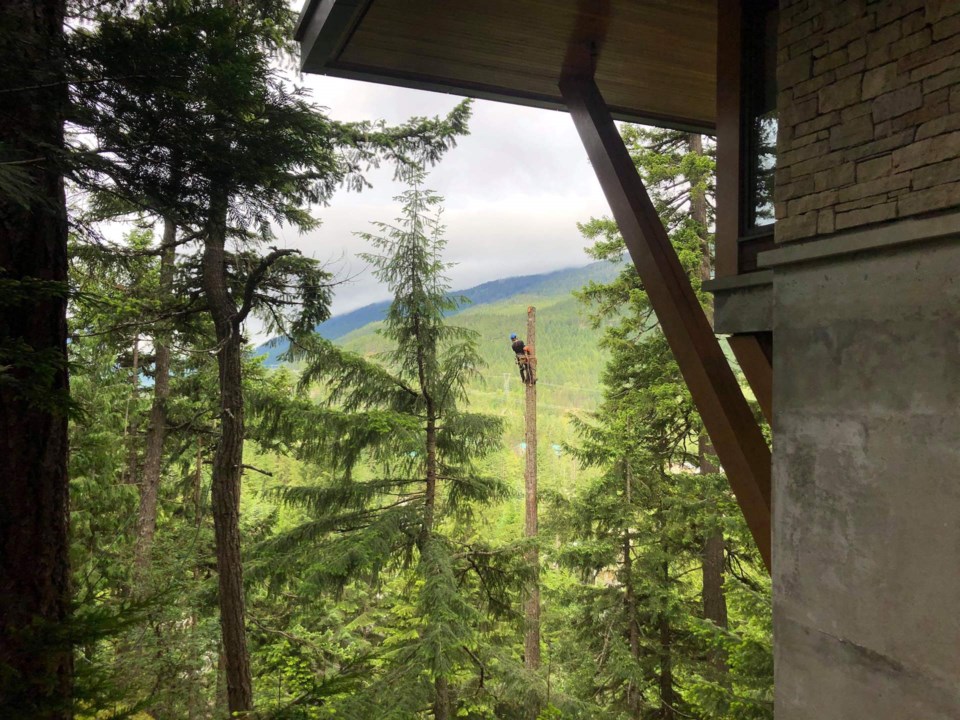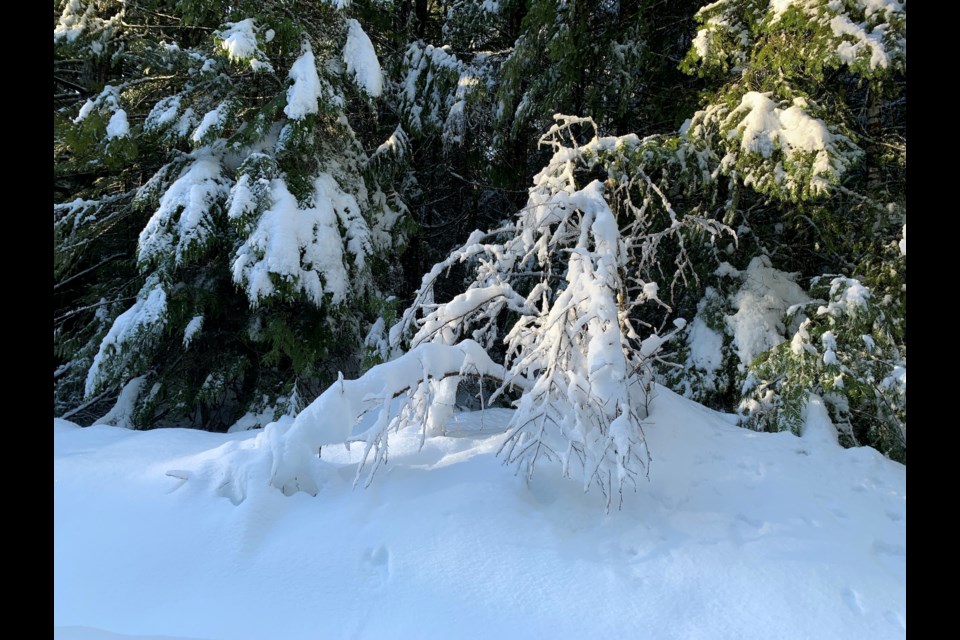Heat dome, atmospheric river events, heavy and continuous snow – the salty stuff often pushed up against their trunks – and then the ice storm.
How are Sea to Sky trees coping with all that has been thrown at them? The Squamish Chief caught up with local tree service owner Paddy Vero of Vertigo Trees to find out what he has seen in the corridor.
What follows is an edited version of that conversation.
Q: How did last week's ice storm impact local trees?
A: It's just so much weight, right? Because our trees haven't been subjected to it since they were young, they aren't adapted to it. So they fail. It definitely affects certain species worse than others. It's just a case of our climate not being the norm.
Q: Is it mostly branches coming down or whole trees?
A: If I go purely off the calls I have received, it’s mostly pieces of tree or branches. But there are trees down. I would say branch damage predominantly.
That's certainly one thing that readers should be aware of, is to look up and see — are there loads of hanging branches that are stuck in there? There might even be some stuck in the snow. Just because they didn't come down yet, doesn't mean they're not going to come down. Those things can come falling out of the tree at any point. It's not a bad idea to either have a look yourself or call a tree service. Get them to look. If there are hazards, we can get up and clear them.
Q: Which species fared OK?
A: Of our standard trees, cedars and hemlocks have probably fared better. They are, generally, bendier, so they can handle it better. Fir trees would have had a hard time; alders would have had a hard time.
Q: In many places around town, snow with salt has been pushed high onto tree trunks. Does this impact them?
A: The trees would rather not have a lot of salt-impregnated snow on it. But the salt is not that huge of an issue. It does kill trees, but it's not like signing a death warrant for a tree if you put some salty snow on the base of it. More significant for residential trees is if you pile a load of snow on the tree, you can actually suffocate the tree when it melts. The tree needs oxygen in its roots. if there's a big lake sitting on a tree that doesn't normally have that much water on it, it will suffocate.
It's not something that I've experienced a lot of in Squamish, purely because we don't normally get this much snow, but I do a lot of work in Whistler, and I spend a lot of time cutting down dead trees in stratas, particularly. Because they just can't handle having that much snow packed around them. And because the snow has been packed in, it takes so long to melt. So come the spring when they're trying to come out of dormancy, they're just being suffocated; they just can't handle it.
Q: So residents should shovel the accumulated snow away from the base of their trees?
A: Shovelling it away from a tree is kind of a Band-Aid for a bullet wound in my opinion. A tree's root plate is kind of the same circumference as its crown under the ground. So that is a monumental amount of snow to try and move. It's really just impractical.
My own opinion is stratas, property developers, managers, should have a plan when the property is being designed. We live in a climate where snow is common. Maybe we should think about where you're going to put the snow when it comes.
Q: What tells you that a tree is hazardous and needs to come down?
A: There are thousands of reasons a tree could be hazardous. For instance, back in the 1960s, 70s and 80s, it was common practice to top a tree. We don't top trees anymore because it creates a hazard.
So let's say the tree was topped in the 1970s. It's been like that for 52 years now. It's still growing. But where it was cut is now rotting. So you've got 50 years of growth on top of a pocket of rot, which is a weak point. So if we see that in a high-risk location, our first thing is, we should probably get rid of this. It's a ticking time bomb.
The weather is a significant factor in it, but a tree can fail at any point. There is no easy guaranteed way to know. We can make educated assessments of trees. We can say yes, this is a significant hazard, we should deal with this before it's too late. But we could never know for sure.
Q: We've had the heat dome and atmospheric river events, and the recent snow and ice events, are these significant stressors to our trees?
A: Definitely. It's not usually any one thing that will kill a tree, but all of these things we have been through are stressors. If you have a month, two months, where the trees are in severe stress because of drought, and then three months down the line, they are being suffocated because they're under three feet of snow than if that tree was struggling before that, it's just gonna struggle worse.
Q: Are you starting to see the cumulative effect of that now with Sea to Sky Corridor trees?
A: I think it will start to show itself in April, May. But those kinds of stresses do take a long time to show themselves. Trees are pretty resilient. There will be the odd tree that has already died, but on the other hand, they can struggle on for decades.
A heat dome event like this summer can literally cook a tree, it can effectively boil in itself. That will show itself fairly quickly. But if it's just a case of it being stressed out, it's not that dissimilar to some sort of long-term health effects that might take you a year or two to actually kill you.
Whereas with Thursday night's ice event, you can see the effect immediately because the tree has fallen over.
Q: With the heat dome, is there any way for folks to prepare their trees better for that?
A: The quantity of water needed to counter that is totally unsustainable. The amount of water a mature tree needs is thousands and thousands of litres. Unfortunately, nature is just going to take its course on that.
Q: How did our trees fare with the rain and flooding in November?
A: It wasn't as profound here. It was more profound in Pemberton. In flooding events, the ground becomes saturated and effectively becomes liquid. And the tree cannot hold itself up. The roots are holding nothing. In the same way that an earthquake affects the ground. It's called liquefaction and the tree just falls over. It doesn't fail from the weight of the water. It just can't hold on to the ground anymore.
Q: So what are you most worried about now with Squamish trees?
A: I'm not worried. Trees are incredibly resilient. A lot of these failures are minor. It's not like a tornado has come through. Trees can adapt. They take a long time to do it, but they're doing it every year, every day. Every time a tree doesn't die, it has adapted slightly to its new conditions. So, I'm not worried at all. We live in a place where trees grow faster than we can cut them down.
Q: What do you recommend folks plant in their yards?
A: If it's an urban setting, I would encourage people to plant smaller species. Not that it's going to affect the homeowner now if you plant a fir in your front yard, it's gonna be 150 years before it's big, right, but it is gonna get big. Try and stick with stuff that is adapted to our area. It doesn't necessarily need to be big cedars. But things that can handle a wide variety of climate.
Q: What types of things do you typically get called out for?
A: Most of our work is removing trees. There's not good pruning practice in Squamish. It is lacking.
I'd like to see homeowners be more proactive. Get pruning done preventatively. Let's reduce some of the leverage on these huge limbs hanging over your house. Prune this tree away from the windows. Let's do this preemptively.




